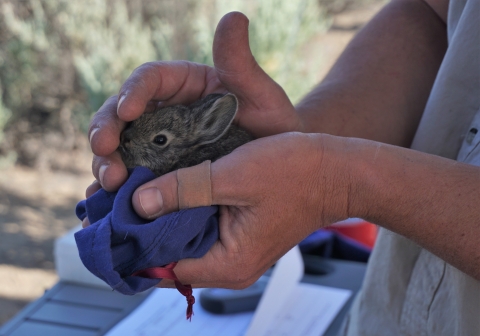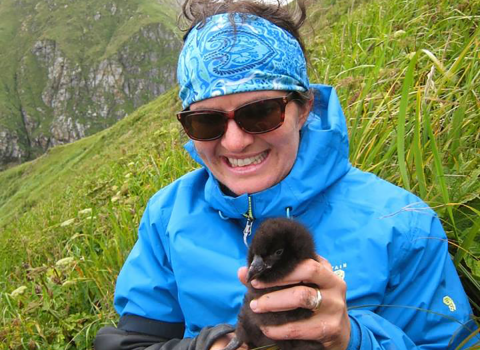By Ann Froschauer, Deputy State Supervisor at the U.S. Fish and Wildlife Service’s Washington Fish and Wildlife Office in Lacey, Washington
EDITOR'S NOTE: This year is the 50th anniversary of the Endangered Species Act, a law that has been a powerful catalyst for conservation of America’s most treasured fish, wildlife, plants and their habitats. In the Pacific Region, our Tribes, state and federal agencies, and partners have joined with our dedicated staff to be the driving force behind the successes we share and the strength ensuring we can address the challenges ahead. Celebrate this milestone with us in this collection of stories as we reflect on past successes, assess current challenges, and envision an equally bright future for the next 50 years and beyond.
Sagebrush habitat can look pretty barren of life at first glance, but this unique ecosystem supports all kinds of life. Endangered Columbia Basin pygmy rabbits are just one of the interesting animals that call sagebrush sagebrush
The western United States’ sagebrush country encompasses over 175 million acres of public and private lands. The sagebrush landscape provides many benefits to our rural economies and communities, and it serves as crucial habitat for a diversity of wildlife, including the iconic greater sage-grouse and over 350 other species.
Learn more about sagebrush habitat home, depending on sagebrush for shelter and food throughout the year. As you might have guessed from their name, pygmy rabbits are tiny, I mean REALLY small. In fact, they are the smallest rabbit in North America, with adults weighing in at about a pound. Their greyish-brown color and short ears provide good camouflage in the sagebrush.
Disturb one, and they “quick like a bunny” disappear into one of their many burrow entrances. Pygmy rabbits dig their own burrows in the deep, loamy soil in the sagebrush. Each burrow may have several entrances, and are often clustered around the base of a sagebrush shrub. Being able to survive in the sagebrush is tough- with summer temperatures over 100 degrees and winter temperatures often below freezing with snowy conditions. There isn’t much food available in winter other than sagebrush, which doesn’t bother the pygmy rabbit a bit. They are one of the few animals that have evolved to eat sagebrush, which can be toxic to many animals. The pygmy rabbit’s winter diet consists of about 99% sagebrush. These rabbits thrive in cooler temperatures, and have very furry feet that help them get around quickly and easily in the snow.
Unfortunately for the pygmy rabbit, much of their habitat has been lost over the years as sagebrush lands were cleared for development and agriculture, and non-native species like cheatgrass overran the native sagebrush. In Washington’s Columbia Basin, the population of pygmy rabbits is a little different from the pygmy rabbit in other parts of its range (which historically included California, Oregon, Nevada, Idaho, Montana, Wyoming, Utah and Washington.) About 10,000 years ago, glaciers isolated the subpopulation of Columbia Basin pygmy rabbits and made it genetically distinct. This loss of genetic diversity put Washington’s Columbia Basin pygmy rabbits at even greater risk as their habitat began to disappear.
In 1993, the pygmy rabbit was listed as state endangered in Washington because of population and distribution declines. By 2001, it was considered almost extinct in the state, with a remnant population on the state’s Sagebrush Flats Wildlife Area. In 2003, the U.S. Fish and Wildlife Service (Service) listed the Columbia Basin pygmy rabbit as a federally endangered species under the Endangered Species Act.
Learn more about how the U.S. Fish and Wildlife Service is working with partners to help Columbia Basin pygmy rabbits recover.



